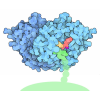+ Open data
Open data
- Basic information
Basic information
| Entry | Database: PDB / ID: 6iuk | |||||||||||||||
|---|---|---|---|---|---|---|---|---|---|---|---|---|---|---|---|---|
| Title | Cryo-EM structure of Murine Norovirus capsid | |||||||||||||||
 Components Components | Major capsid protein VP1 | |||||||||||||||
 Keywords Keywords | VIRUS / VLP / mature / stable | |||||||||||||||
| Function / homology | Calicivirus coat protein C-terminal / Calicivirus coat protein C-terminal / Calicivirus coat protein / Calicivirus coat protein / Picornavirus/Calicivirus coat protein / Viral coat protein subunit / Capsid protein Function and homology information Function and homology information | |||||||||||||||
| Biological species |  Murine norovirus GV/NIH-2410/2005/USA Murine norovirus GV/NIH-2410/2005/USA | |||||||||||||||
| Method | ELECTRON MICROSCOPY / single particle reconstruction / cryo EM / Resolution: 3.5 Å | |||||||||||||||
 Authors Authors | Song, C. / Miyazaki, N. / Iwasaki, K. / Katayama, K. / Murata, K. | |||||||||||||||
| Funding support |  Japan, 4items Japan, 4items
| |||||||||||||||
 Citation Citation |  Journal: PLoS Pathog / Year: 2020 Journal: PLoS Pathog / Year: 2020Title: Dynamic rotation of the protruding domain enhances the infectivity of norovirus. Authors: Chihong Song / Reiko Takai-Todaka / Motohiro Miki / Kei Haga / Akira Fujimoto / Ryoka Ishiyama / Kazuki Oikawa / Masaru Yokoyama / Naoyuki Miyazaki / Kenji Iwasaki / Kosuke Murakami / ...Authors: Chihong Song / Reiko Takai-Todaka / Motohiro Miki / Kei Haga / Akira Fujimoto / Ryoka Ishiyama / Kazuki Oikawa / Masaru Yokoyama / Naoyuki Miyazaki / Kenji Iwasaki / Kosuke Murakami / Kazuhiko Katayama / Kazuyoshi Murata /  Abstract: Norovirus is the major cause of epidemic nonbacterial gastroenteritis worldwide. Lack of structural information on infection and replication mechanisms hampers the development of effective vaccines ...Norovirus is the major cause of epidemic nonbacterial gastroenteritis worldwide. Lack of structural information on infection and replication mechanisms hampers the development of effective vaccines and remedies. Here, using cryo-electron microscopy, we show that the capsid structure of murine noroviruses changes in response to aqueous conditions. By twisting the flexible hinge connecting two domains, the protruding (P) domain reversibly rises off the shell (S) domain in solutions of higher pH, but rests on the S domain in solutions of lower pH. Metal ions help to stabilize the resting conformation in this process. Furthermore, in the resting conformation, the cellular receptor CD300lf is readily accessible, and thus infection efficiency is significantly enhanced. Two similar P domain conformations were also found simultaneously in the human norovirus GII.3 capsid, although the mechanism of the conformational change is not yet clear. These results provide new insights into the mechanisms of non-enveloped norovirus transmission that invades host cells, replicates, and sometimes escapes the hosts immune system, through dramatic environmental changes in the gastrointestinal tract. | |||||||||||||||
| History |
|
- Structure visualization
Structure visualization
| Movie |
 Movie viewer Movie viewer |
|---|---|
| Structure viewer | Molecule:  Molmil Molmil Jmol/JSmol Jmol/JSmol |
- Downloads & links
Downloads & links
- Download
Download
| PDBx/mmCIF format |  6iuk.cif.gz 6iuk.cif.gz | 263.3 KB | Display |  PDBx/mmCIF format PDBx/mmCIF format |
|---|---|---|---|---|
| PDB format |  pdb6iuk.ent.gz pdb6iuk.ent.gz | 215.6 KB | Display |  PDB format PDB format |
| PDBx/mmJSON format |  6iuk.json.gz 6iuk.json.gz | Tree view |  PDBx/mmJSON format PDBx/mmJSON format | |
| Others |  Other downloads Other downloads |
-Validation report
| Summary document |  6iuk_validation.pdf.gz 6iuk_validation.pdf.gz | 1 MB | Display |  wwPDB validaton report wwPDB validaton report |
|---|---|---|---|---|
| Full document |  6iuk_full_validation.pdf.gz 6iuk_full_validation.pdf.gz | 1 MB | Display | |
| Data in XML |  6iuk_validation.xml.gz 6iuk_validation.xml.gz | 56.9 KB | Display | |
| Data in CIF |  6iuk_validation.cif.gz 6iuk_validation.cif.gz | 85.7 KB | Display | |
| Arichive directory |  https://data.pdbj.org/pub/pdb/validation_reports/iu/6iuk https://data.pdbj.org/pub/pdb/validation_reports/iu/6iuk ftp://data.pdbj.org/pub/pdb/validation_reports/iu/6iuk ftp://data.pdbj.org/pub/pdb/validation_reports/iu/6iuk | HTTPS FTP |
-Related structure data
| Related structure data |  9741MC  9735C  9736C  9737C  9738C  9739C  9740C C: citing same article ( M: map data used to model this data |
|---|---|
| Similar structure data |
- Links
Links
- Assembly
Assembly
| Deposited unit | 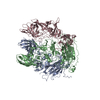
|
|---|---|
| 1 | x 60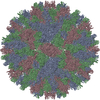
|
| 2 |
|
| 3 | x 5
|
| 4 | x 6
|
| 5 | 
|
| Symmetry | Point symmetry: (Schoenflies symbol: I (icosahedral)) |
- Components
Components
| #1: Protein | Mass: 58833.785 Da / Num. of mol.: 3 Source method: isolated from a genetically manipulated source Source: (gene. exp.)  Murine norovirus GV/NIH-2410/2005/USA / Gene: VP1 / Production host: Murine norovirus GV/NIH-2410/2005/USA / Gene: VP1 / Production host:  Baculovirus expression vector pFastBac1-HM / References: UniProt: B7XA03 Baculovirus expression vector pFastBac1-HM / References: UniProt: B7XA03 |
|---|
-Experimental details
-Experiment
| Experiment | Method: ELECTRON MICROSCOPY |
|---|---|
| EM experiment | Aggregation state: PARTICLE / 3D reconstruction method: single particle reconstruction |
- Sample preparation
Sample preparation
| Component | Name: Murine norovirus GV / Type: VIRUS / Entity ID: all / Source: RECOMBINANT |
|---|---|
| Molecular weight | Experimental value: NO |
| Source (natural) | Organism:  Murine norovirus GV Murine norovirus GV |
| Source (recombinant) | Organism:  Baculovirus expression vector pFastBac1-HM / Cell: RAW264.7 / Plasmid: cDNA Baculovirus expression vector pFastBac1-HM / Cell: RAW264.7 / Plasmid: cDNA |
| Details of virus | Empty: YES / Enveloped: NO / Isolate: SPECIES / Type: VIRUS-LIKE PARTICLE |
| Natural host | Organism: Mus musculus |
| Virus shell | Diameter: 400 nm / Triangulation number (T number): 3 |
| Buffer solution | pH: 7.4 |
| Specimen | Embedding applied: YES / Shadowing applied: NO / Staining applied: NO / Vitrification applied: YES |
| EM embedding | Material: amorphous ice |
| Vitrification | Cryogen name: ETHANE / Humidity: 95 % / Chamber temperature: 277 K |
- Electron microscopy imaging
Electron microscopy imaging
| Experimental equipment |  Model: Titan Krios / Image courtesy: FEI Company |
|---|---|
| Microscopy | Model: FEI TITAN KRIOS |
| Electron gun | Electron source:  FIELD EMISSION GUN / Accelerating voltage: 300 kV / Illumination mode: FLOOD BEAM FIELD EMISSION GUN / Accelerating voltage: 300 kV / Illumination mode: FLOOD BEAM |
| Electron lens | Mode: BRIGHT FIELD / Nominal magnification: 75000 X / Nominal defocus max: 2500 nm / Nominal defocus min: 1000 nm / Cs: 0.1 mm / C2 aperture diameter: 100 µm / Alignment procedure: BASIC |
| Specimen holder | Cryogen: NITROGEN / Specimen holder model: FEI TITAN KRIOS AUTOGRID HOLDER / Temperature (max): 77 K / Temperature (min): 76 K |
| Image recording | Average exposure time: 2 sec. / Electron dose: 40 e/Å2 / Film or detector model: FEI FALCON II (4k x 4k) / Num. of real images: 2746 |
| Image scans | Width: 4096 / Height: 4096 / Movie frames/image: 32 / Used frames/image: 3-31 |
- Processing
Processing
| EM software |
| ||||||||||||||||||||||||||||||||||||
|---|---|---|---|---|---|---|---|---|---|---|---|---|---|---|---|---|---|---|---|---|---|---|---|---|---|---|---|---|---|---|---|---|---|---|---|---|---|
| CTF correction | Type: PHASE FLIPPING ONLY | ||||||||||||||||||||||||||||||||||||
| Symmetry | Point symmetry: I (icosahedral) | ||||||||||||||||||||||||||||||||||||
| 3D reconstruction | Resolution: 3.5 Å / Resolution method: FSC 0.143 CUT-OFF / Num. of particles: 41847 / Symmetry type: POINT | ||||||||||||||||||||||||||||||||||||
| Atomic model building | B value: 157 / Protocol: FLEXIBLE FIT / Space: REAL |
 Movie
Movie Controller
Controller



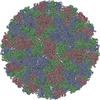

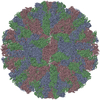
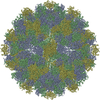
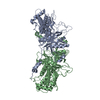
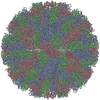
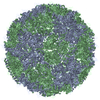
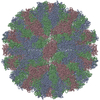

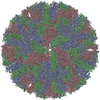
 PDBj
PDBj